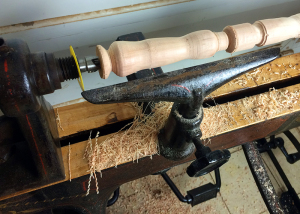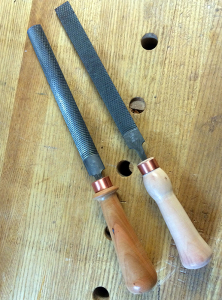Match the Handle Shape to the Tool’s Task
 I have some very beautiful tools. Most of them made by someone else with a lot more skill and patience than I. It has taken me a long time to acquire them (and a lot of $$$) so I’m very proud to use them. So when it comes to making my own tools, the bar is set very high. For instance, in doing some sea trials of my Barnes lathe I decided to make some more handles for files, rasps, and a few chisels One might also say I was procrastinating from what I should have been doing, but that’s a different story.
I have some very beautiful tools. Most of them made by someone else with a lot more skill and patience than I. It has taken me a long time to acquire them (and a lot of $$$) so I’m very proud to use them. So when it comes to making my own tools, the bar is set very high. For instance, in doing some sea trials of my Barnes lathe I decided to make some more handles for files, rasps, and a few chisels One might also say I was procrastinating from what I should have been doing, but that’s a different story.
With my other strikingly beautiful tools, it seems mandatory that at least put some effort towards matching that aesthetic. So I pull out nice scraps and shape lovely flowing curves and beads onto something as humble as a file handle. But here’s the thing, rarely do I make more than one handle identical in shape. I view these projects as proving grounds for new shapes and if nothing else an outlet to practice my woodturning skills. I always focus on making sure the handle fits my hand and is comfortable, but I’m continually tweaking the size of the “bulb” at the end and the detail near the ferrule. I find I like a larger bulb that fits into the palm of my hand and gives me comfortable leverage. At the same time a larger detail at the ferrule helps to restrain my fingers and gives them something to grip when doing precise work with the rasp or file. I keep varying this and find that some tools need different shapes based on how I use it and how coarse or fine it is.
 Coming fresh out of a WoodTalk episode that we actually called “The OCD Woodworker“, I’m keenly aware that my mismatched file and raps handles will make the skin crawl of a surprising number of woodworkers. So to fan this fire, let me say that I do the same thing with chisels handles. For some reason that feels even more egregious.
Coming fresh out of a WoodTalk episode that we actually called “The OCD Woodworker“, I’m keenly aware that my mismatched file and raps handles will make the skin crawl of a surprising number of woodworkers. So to fan this fire, let me say that I do the same thing with chisels handles. For some reason that feels even more egregious.
But this is a perfect example of matching the handle to the tool. The flat rasp on the right I use to shape convex curves and flattening out surfaces. I tend to grip it much like a saw handle in that my index finger is extended along the shank. Adjusting the pressure of that fingers allows me to feel the curve a lot better. So the gentle bead by the ferrule nicely fits into the recess under my first knuckle. Moreover, this rasp is double sided and I can flip it around easier with a more vanilla shaped handle.
On the converse is the half round rasp on the left. There is a sharply defined bead here and a deep cove right behind it. When I’m using this rasp I do a lot of rolling and twisting of the blade as I refine complex inside curves. I will change grips more often here with my finger extended sometimes and sometimes not. More often than not its a hybrid of the two where my index finger will curl around the bead for a more tactile, positive grip when rotating the rasp. This sharper bead is perfect for that.
In both examples you will see a larger bulb at the end that nestles comfortable in the palm of my hand for hours of use. I don’t get the tiny, tapered and pointy file handles I see from many makers. They force you to grip the handle much more instead of using your palm to restrain the handle and therefore they are more tiring to use and I feel like you have less control.
I don’t think I will ever find the perfect shape and then make all of my handles the same because I don’t ask my tools to do the same task. Maybe this will sooth the eye twitch of the OCD guys out there knowing that there is an ergonomic design behind the different shapes…I can’t help you on the different species aspect.
So think twice before you start batching out identical handles for different tools. There is a functional reason to make them different. It’s also a way to justify one’s mediocre turning skills and difficulty with duplicating shapes (so I hear).
Of course the rasps shown are heading off to a Chips ‘n Tips winner so I sure hope his OCD can handle it.


